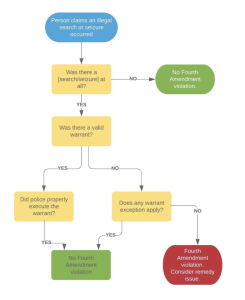Fourth Amendment Flowchart Exercise
Fourth Amendment Flowchart Exercise
Flowcharts can help students visualize what they have learned. The goal is not to memorize the example chart presented here but instead to create a new chart that helps one to connect material from throughout the book. Your authors recommend that when students make their own charts, they add additional detail, such as case names or chapter numbers. For example, in the box asking whether there was a “search” or “seizure” at all, students might add information related to dog sniffs, aerial surveillance, the open fields doctrine, thermal imaging, garbage collection, and other items included in the early chapters of this book.

In the box asking if there was a valid warrant, students might add information related to the particularity requirement, as well as other sources of challenges to validity.
This chart focuses on the Fourth Amendment. Later in the book, a different sample chart focuses on the Miranda Rule.
These charts have two primary purposes. One is that when the charts are finished, they can serve as study aids. The other is that the creation of the charts—even if students never review them after finishing them—forces students to consider material more carefully than they otherwise might, which helps with learning and with retention of information. Also, fellow students can help spot misunderstandings that, were they not in a chart, would remain uncorrected. Study group members might wish to bring charts to share with classmates.
Note that the “Fourth Amendment violation” box asks students to consider what remedy might be available to the person whose rights were violated. A separate chart devoted to remedies (such as the exclusionary rule) would be worth creating after students cover that material.

